Unique Facilities
The U.S. Army Combat Capabilities Development Command Chemical Biological Center (DEVCOM Chemical Biological Center) has over 25 unique facilities that provide full life-cycle support to chemical and biological protection, detection, and monitoring activities.
Some of the buildings are capable of handling items contaminated with chemical, biological or radiological materials, and represent few of the only structures in the nation equipped to handle unknown toxic items. In addition, many of these facilities are independently accredited by international organizations and operate under Good Laboratory Practices protocols.
Facilities at a glance:
- $1.8 billion in facilities, equipment
- 1.22 million square feet of laboratory and chamber space
- Sophisticated environmental controls
- Explosive containment chambers
- Robotic components
- 317 chemical surety hoods
- 66 BSL-2 and BSL-3 hoods
- 3 Toxic test chambers
- 30 Multi-purpose mobile platforms for air monitoring
- 30 operational mobile laboratories with hoods and glove boxes
Major Facilities
Advanced Chemistry Laboratory
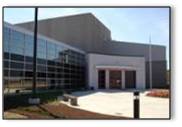
- Built 2005, 133,937 Sq. Feet
- Description/History: Chemistry laboratory
The Advanced Chemistry Laboratory (ACL) is a unique facility designed for working with the most super toxic compounds known to man. Highly instrumented and adaptable, the ACL is designed for flexibility so that it can address the ever-changing requirements of scientific advancement. Safety in and outside the laboratory is a primary consideration. Primary facilities within the ACL include advanced toxic agent laboratories, environmental chambers, and secure work spaces for classified materials. Chemical agent operations in this building include analytical chemistry, Chemical Weapons Convention (CWC) treaty support, filtration, decontamination and evaluation of chemical agent detectors.
McNamara Life Sciences Building
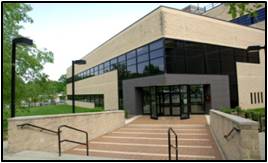
- Built 1997, 119,000 Sq. Feet
- Description/History: General purpose laboratory test building
The McNamara Life Sciences building allows scientists to manage and execute the Department of Defense Science & Technology programs and monitor international efforts in Chemical Biological (CB) Defense and Smoke & Target Defeat while supporting the full-spectrum of vital U.S. CB Defense program efforts. The facility’s original mission was to perform toxicology research. McNamara houses BSL 2/3 labs and has state of the art equipment to safely conduct inhalation studies for chemical agents. The facility also allows scientists to conduct basic and applied research on non-medical countermeasures, pathogenicity studies, gene regulators and detection evaluation that rely upon moderate risk microorganisms to those causing serious and potential lethal infection up to and including BSL3.
Bio Engineering Laboratory
- Built 1991, 20,000 Sq. Feet
- Description/History: Chemistry and biology laboratories
The Bio Engineering Laboratory (BeL) is the only full spectrum biotechnology capability within the Department of Defense (DoD). It is fully staffed for industrial-scale production of bio-molecules used in detection and decontamination systems fielded to the Warfighter and to civilian responders. The BeL is an engineering facility with fermentation ranging from 5L to 1500L, along with matching scale downstream protein separation, purification lyophilization and spray drying. The BeL also houses a biosurety-compliant, secure, state-of-the-are cold storage capability.
Forensic Analytical Center
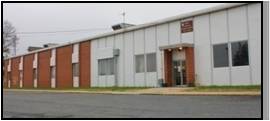
- Built 1993, 29,900 Sq. Feet
- Description/History: Chemistry/ biology laboratory
The Forensic Analytical Center allows scientists to analyze hundreds of relatively routine samples and conduct highly sophisticated chemical analysis on samples that may contain unusual materials and trace amounts of materials, including chemical and biological warfare agents for which results may be expected within hours or days.
The lab and its specialized equipment are independently accredited by international Organizations to ISO 9001, and ISO Guide 25/17025.
Engineering & Test Facilities
Toxic Test Chambers

- Built 1943, 7,320 Sq. Feet
- Description/History: Hazardous material test facility
—
- Built 1971 3,680 Sq. Feet
- Description/History: Hazardous material test facility
Both facilities have 16,000 cubic foot chambers, equipped with 5000 CFM CBR filter systems with an air change approximately every three minutes maintaining the chambers under negative pressure, uniquely designed for total containment in the testing of chemical (military and industrial) related equipment, and explosive/toxic munitions/materials. Chemical warfare agents and explosives may be tested simultaneously. An on-site surety lab is equipped with GC/MS, HPLC, Dynatherm, and wet lab capabilities to perform agent analysis to RDTE drinking standards.
The Prototype Detonation Test and Destruction Facility (PDTDF) is capable of testing technologies that require various site layouts. The facility is located at J-Field in the Edgewood area of Aberdeen Proving Ground, Md. The PDTDF can accommodate the heaviest of the transportable systems that are currently in use.
Some previous systems that have been tested include Large Item Transportable Access and Neutralization System (LITANS), Explosive Destruction System (EDS), and the Transportable Detonation Chamber (TDC).
The environmentally controlled chamber is monitored by an onsite monitoring room and has the capability of providing supplied air and decontamination services. Personal protective equipment storage and changing rooms are connected to the chamber to allow ease of egress and ingress. The PDTDF permits have been approved for up to 1 pounds TNT-equivalent. However, current destructions systems located at the site have been approved for 62.5 pounds TNT-equivalent explosives.
Berger Engineering Complex
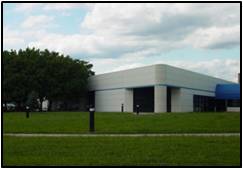
- Built 1989, 137,409 Sq. Feet
- Description/History: Engineering laboratory
The Berger Lab Complex is a multi-purpose building with professional office, 100 seat auditorium, general purpose labs, and high bay test areas for handling combat vehicles. Berger’s laboratories help to develop defensive equipment used by Warfighters under nuclear, biological and chemical attack and to conduct biological research.
The complex includes a 32,000 square foot Test Bay Area, which is composed of five test bays that are two-stories high. The bays are specifically designed so that a typical combat vehicle can be driven into them for any functional testing. They are also equipped with movable and detachable engine exhaust hoses and rooftop ventilators. The high bay area serves as a production line area with space for up to 10 High Mobility Multipurpose Wheeled Vehicles (HMMWVs) at one time.
Computer Aided Design, experimental fabrication, and the electronics lab can be accessed from this area. This facility allows items to be assembled, tested, and sent out the door all from a single location.
Protection Factor Test Facility
RDECOM ECBC maintains the Protection Factor (PF) Test Facility. The PF Test Facility is designed to evaluate chemical, biological, radiological and nuclear (CBRN) protective capabilities of respirator systems such as masks and clothing. In order to simulate exposure to chemical agents, volunteers don test items and enter a test chamber containing a polydispersed corn oil aerosol challenge. The corn oil aerosol is between 0.4 and 0.6 micron in diameter and has an air concentration of 20-40 mg/m3. The air inside the protective equipment is sampled for challenge aerosol particles while the subject undergoes a series of exercises intended to evaluate worst-case operational conditions. There is a standard set of exercises used during testing but the customer may specify exercises pending approval by the Human Use Committee. Sampling is accomplished through a length of silicon tubing that is connected from the mask and/or suit to the laser photometers. The protection factor (also known as fit factor) results are graphically displayed real-time on a computer monitor.
The facility comprises an entrance airlock and aerosol exposure chamber that can accommodate up to sixteen volunteers and is designed for flexible protocol setup. Human Performance testing is conducted to ensure comfort, fit, breathing resistance, vision, and communication aptitude of the protective ensemble. Active vapor testing is used if additional testing is needed. Vapor Testing, just as Aerosol Testing provides real-time active sampling. Methyl Salicylate is the primary substance used for vapor testing.
New, One-of-a-Kind Facilities
Standoff Detection Technology Evaluation Facility
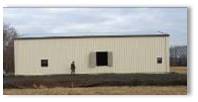
The Standoff Detection Technology Evaluation facility is the only one of its kind in the country and allows researchers to release a known amount of material while maintaining a calibrated material scatter so that a standoff detector’s ability to “see” can be accurately measured from up to several kilometers away. This increased precision reduces uncertainty about the potential field performance of standoff detectors.
The Standoff Detection Technology Evaluation Facility was designed for use in the Artemis Chemical Standoff Detection Program to allow aerosol backscatter and vapor measurements with a frequency-agile carbon dioxide (CO2) Light Detection and Ranging (LIDAR) standoff detector. The chamber utilizes curtains of air produced by an interior vortex and balanced by an exterior counter flow of air to contain the material cloud. This also prevents the backscatter off of conventional hard windows from corrupting the desired measurements on the cloud inside the chamber. The prevention of backscatter is critical because the CO2 LIDAR has a long (1 microsecond) pulse and the backscatter off the window cannot be temporarily separated from the backscatter off of an aerosol in the chamber.
With known and modest modifications, this DEVCOM Chemical Biological Center asset can be used with all passive and active, chemical and biological standoff technologies and systems at any stage of development. The chamber was designed for testing with a variety of CB simulants, interferents and selected toxic industrial chemicals in both vapor and aerosol form. DEVCOM Chemical Biological Center is exploring the regulatory acceptability of extending the operations to include “kill” pathogens, which would produce a tremendous benefit for the CBDP if permitted. Using state-of-the- art ground truth instrumentation, the Standoff Detection Technology Evaluation Facility has been shown to successfully contain a homogenous aerosol cloud.
Sample Receipt Facility (SRF)

The Sample Receipt Facility is the first full-range, interagency resource, funded by the U.S. Army, the FBI and the Department of Homeland Security, to receive, triage, sample and screen “unknowns” with the potential of chemical, biological, radiological or explosive configurations.
Chemical Transfer (Single Small-Scale) Facility
- Built 1983, 13,264 Sq. Feet
- Description/History: Chemistry laboratory
The Chemical Transfer Facility (CTF) is the only U.S. single small-scale facility, a single repository for the Army’s research and development stock of toxic chemical agents. The CTF is a Category II Security/Storage Facility, which houses bulk storage of chemical agents in accessible containers intended for withdrawal and issue to support research, development, testing and/or training operations. The CTF is the only location within the U.S. where chemical compounds defined by the Chemical Weapons Convention (CWC) can be produced in amounts greater than 100 mls per year.
